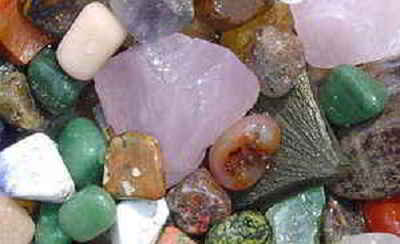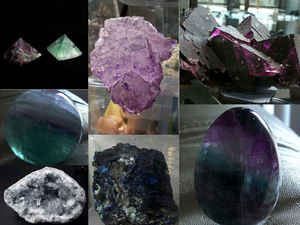Illinois State Mineral
Fluorite

(CaF2)
Adopted in 1965.
Fluorite was adopted in 1965 as the Illinois State Mineral. Fluorite is the natural crystalline form of calcium fluoride (CaF2). It is a transparent to translucent, glassy mineral. When pure, fluorite is colorless; however, it usually contains impurities that color it. The most common colors are violet, blue, green, yellow, brown, pink, and blue-black; a single crystal may have bands of several colors. Fluorite often forms beautiful cube-shaped crystals.
Illinois State Mineral: Fluorite

The name fluorite comes
from the Latin flu ere which means "to flow." This name comes from the fact that fluorite melts easily. Fluorite is the natural crystalline
form of calcium fluoride (CaF2). It is a transparent to translucent, glassy mineral. When pure fluorite is crystal clear, however fluorite can show
many different colors depending on tiny amounts of other elements taking the place of the calcium in the molecular structure. Sometimes a single crystal
may have bands of several colors. Fluorite often forms beautiful cube-shaped crystals. For a better look at some spectacular fluorite crystals, take
a look at this QTVR object movie.
The most important fluorite deposits in the United States are found at Rosiclare and Cave-in-Rock in southern Illinois. At Rosiclare, fluorite occurs
in veins in the limestone bedrock. Some of these veins are as much as 40 feet wide (12 m). Because of these deposits, Illinois is the largest producer
of fluorite in the United States.
The deposits in Illinois were formed as hot water flowed up into the limestone of the area from deeper in the earth. Mineral deposits formed in this
manner are called hydrothermal deposits. The hot water flowed up along weak areas in the rocks of this area. These weak areas are associated with the
faults of the Wabash and Reelfoot rift zones. These two rift zones are responsible for earthquakes such as the famous series of quakes at New Madrid,
Missouri. The southern Illinois Fluorite deposits probably formed between 100 and 250 million years ago.
Fluorite is an important industrial mineral. The most common use is as a flux in producing steel. Another important use is in making hydrofluoric acid,
which is used in pottery, optics, and plastics. Fluorite is also used in making opalescent glass and in enameling cookware.
Name: Even though fluorite contains the element fluorine, its name is not derived from its chemical composition. The name was given by Georg
Agricola in 1546 and was derived from the Latin verb fluere which means to flow because it melts easily.
Spar is a generic name used by mineralogists to refer to any non-metallic mineral that breaks easily to produce flat surfaces and which has a glassy
luster.
A miner's name used long ago for fluorite was Blue John.
PHYSICAL CHARACTERISTICS OF FLORITE:

- Color is extremely variable and many times can be an intense purple, blue, green or yellow; also colorless, reddish orange, pink, white and brown. A single crystal can be multi-colored.
- Luster is vitreous.
- Transparency: Crystals are transparent to translucent.
- Crystal System: Isometric; 4/m bar 3 2/m
- Crystal Habits include the typical cube and to a lesser extent, the octahedron as well as combinations of these two and other rarer isometric habits. Always with equant crystals; less common are crusts and botryoidal forms. Twinning also produces penetration twins that look like two cubes grown together.
- Cleavage is perfect in 4 directions forming octahedrons.
- Fracture is irregular and brittle.
- Hardness is 4
- Specific Gravity is 3.1+ (average)
- Streak is white.
- Other Characteristics: Often fluorescent blue or more rarely green, white, red or violet and may be thermoluminescent, phosphorescent and triboluminescent.
- Associated Minerals are many and include calcite, quartz, willemite, barite, witherite, apatite, chalcopyrite, galena, sphalerite, pyrite and other sulfides
- Notable Occurrences include in addition to those mentioned above Cumberland, England; Spain; China; Brazil; Morocco; Bancroft, Ontario, Canada; Naica, Chihuahua, Mexico; Germany; Elmwood, Tennessee; Rosiclare, Illinois; Fort Wayne, Indiana; Pugh Quarry and Wood County, Ohio; Nancy Hanks Mine, Colorado and many other USA localities as well as many other localities from around the world.
- Best Field Indicators are crystal habit, color zoning, hardness (harder than calcite, but softer than quartz or apatite), fluorescence and especially the octahedral cleavage.
Myth & Lore:

According to folklore, Fluorite was once
thought to be the "home of the rainbow" due to the crystal's wide range of colors which many times grow intermingled or side by side.
Throughout ancient history, it has been carved into statues, decorative art, amulets and talismans in many locales around the globe.
The early Egyptians were known to carve scarabs from the stone along with using colorful specimens in many of their deity statues.
The Chinese have been carving Fluorite for over 300 years. And, likened to Amethyst, the ancient Romans believed that a drinking vessel
made of Fluorite would also prevent a person from getting drunk. Roman scholar and naturalist, Pliny (known as "The Elder"), thought
Fluorite a very precious stone, as was witnessed in the valuable vase Augustus took from Alexandria. Six other vases of Fluorite were taken from
Mithridates' treasures and brought to the temple of Jupiter.
In matters of health, in the 18th century, a mixture of water and powdered Fluorite was used to alleviate the symptoms of kidney disease.
Today it is most often used metaphysically to enhance and clarify thought processes, and also as a protection stone.
Illinois Law
The law designating the calcium fluoride as the official Illinois state mineral is found in the Illinois Compiled Statutes, Government, Chapter 5, State Designations Act, Section 25.
GENERAL PROVISIONS
(5 ILCS 460/) State Designations Act.
(5 ILCS 460/25) (from Ch. 1, par. 2901-25)
Sec. 25. State mineral. The mineral calcium fluoride, commonly called "fluorite", is designated the official State mineral of the State of
Illinois.
(Source: P.A. 90-655, eff. 7-30-98.)
Minerals, & Gems

Gemstone, Minerals, Rocks







